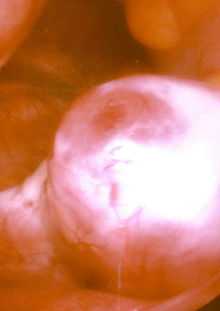Stigma (anatomy)
From Wikipedia, the free encyclopedia
Not to be confused with Astigmatism.

Stigma of the human ovary: the follicle is about to burst
A stigma in mammalian reproductive anatomy refers to the area of the ovarian surface where the Graafian follicle will burst through during ovulation and release the ovum.[1]
As the follicle matures, the area between the follicle and the ovarian surface begins to thin and weaken under the influence of the luteinizing hormone and local cytokines. At ovulation the stigma ruptures and the secondary oocyte is released along with follicular fluid. The secondary oocyte needs to be captured by the fallopian tube where it could be fertilized by a sperm cell. The stigma will heal and the residual follicle is transformed into the corpus luteum.
References
This article is issued from Wikipedia. The text is available under the Creative Commons Attribution/Share Alike; additional terms may apply for the media files.